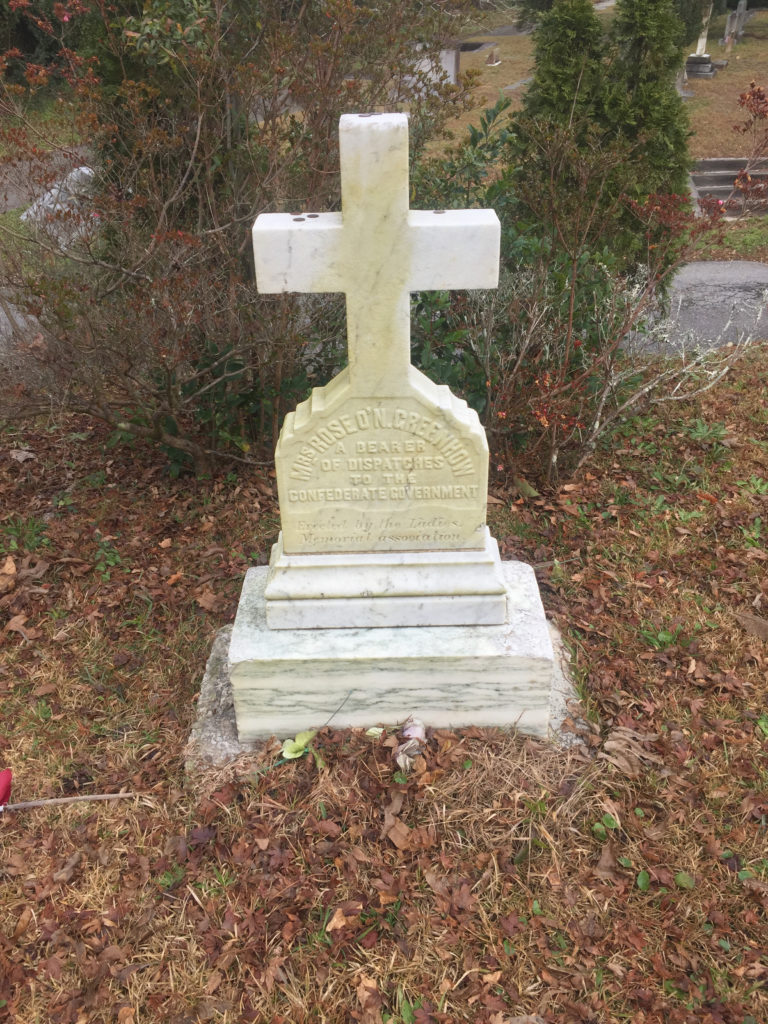Erik Visits an American Grave, Part 843
This is the grave of Rose O’Neal Greenhow.

Born in 1813 on a plantation in Montgomery County, Maryland Maria Rosetta O’Neale, grew up in relatively comfortable circumstances. Her father was a middling planter, a slaveholder, but not one of the true elites. She went by Rose from the time she was a child. I am not sure why or when she changed the spelling of her last name, but doing this series over the years, I can say this was not uncommon in the era. What was great is that her father was killed by own slave valet in 1817. I don’t necessarily root for someone to become an orphan, but I most definitely cheer the murder of a slaveholder by his slave.
In 1830, Rose and her sister were sent to live with an aunt who ran a fashionable boarding house in Washington, D.C. This place them into Washington society. Her sister married Dolley Madison’s nephew and their daughter later married Stephen A. Douglas. Rose was courted by and agreed to marry Robert Greenhow, a prominent Virginia doctor and lawyer, in 1835. They lived in Washington and were central to the city’s elite society. Her husband worked in the State Department in these years. He was sent to Mexico City in 1850 and Rose and the children went with him, then onto San Francisco in 1852. The next year, she and the children returned to Washington while she was pregnant. Greenhow died in San Francisco in 1854 and she was a widow. This didn’t seem to bother her too much and she reclaimed her role in Washington society.
Rose Greenhow was a good friend with another long-time veteran of Washington society–John C. Calhoun. They shared a love of slavery. So as the nation moved toward Civil War, she adopted his positions and upheld them after his death. She became an ardent secessionist. When the war started, Confederates immediately called on her to be a spy. This disgusting traitor agreed. And she became one of the most effective spies in the entire Confederacy. Women were quite frequently spies, since they were seen as non-combatants and mid-nineteenth century gender roles opened up a lot of space for them before they would be confronted with their treasonous slaver activities.
Almost immediately, her work paid off. She sent Beauregard critical information on Union movements before First Manassas, including much of Irvin McDowell’s plans and strategy. In fact, Jefferson Davis later gave her credit for the Confederate victory there. That alone makes her among the worst Americans in history. Southern elites called her the “Rebel Rose” for her work.
After Lincoln’s near assassination on his route to Washington, the new president created the Secret Service (not that it was particularly effective, as he would sadly discover in 1865). Its head was one Allan Pinkerton, later known for his anti-labor actions. As it turns out, Greenhow was not subtle about her work. So she came under Pinkerton’s eye pretty quickly because she had so many visitors known to be sympathetic to the traitors. Pinkerton let her operate but also intercepted and read her messages. Her handlers in the South realized this and so she wasn’t as important to them at that point. She knew he was following her too. And then he placed her under house arrest. So, having the gall of a traitor, she wrote to Secretary of State William Seward complaining about how mean and ungentlemanly he was. Why was she so effective? As it turns out, the abolitionist senator Henry Wilson from Massachusetts was in love with her and he just spilled the beans on everything. So that’s just great….
Eventually, Greenhow was sent to prison, but she had a lot of autonomy in the prison, being a woman, including having her daughter live with her. And she still had access to information and sent coded messages to her handlers. In May 1862, she was released without trial and expelled to the Confederacy on the condition that she stay there. She toured the South as a hero. Jefferson Davis then sent her to Europe as a courier. She was quite effective there, building on support for the traitors in the European aristocracy. She even had a meeting with both Napoleon III and Queen Victoria. She became engaged to Granville Leveson-Gower, 2nd Earl Granville, in 1864. She also published her memoir My Imprisonment and the First Year of Abolition Rule at Washington. I’m sure it’s a very special book.
But before she settled in England as a member of the aristocracy, she needed to return to the Confederacy to complete her mission. On October 1, 1864, the ship she was on ran aground at the mouth of the Cape Fear River, near Wilmington, North Carolina, as a Union gunboat pursued it. She got in a raft to save herself and her mission, including key letters of support and $2,000 of gold sewn into her clothing. A wave washed her overboard and she drowned. Good. I wish more traitors had suffered this fate, especially spies.
Rose O’Neill Greenhow is buried in Oakdale Cemetery, Wilmington, North Carolina. The stone itself is from 1888.
This grave visit was sponsored by LGM reader donations on my recent trip to the South. I have another trip planned for next month to some of our least fortunate states, which thus means lots of really bad people will be featured soon. If you would like this series to visit other Confederate spies, you can donate to cover the required expenses here. Thomas Jordan, who was Greenhow’s handler and who later became a Confederate general, is in Hastings-on-Hudson, New York, and Bettie Duval Webb, who was one of Greenhow’s courtiers, is in Washington, D.C. Previous posts in this series are archived here.


